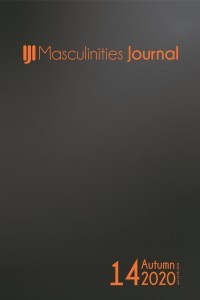Bir Osmanlı Fetişi Olarak Modernite: Kesik Bıyık’ta Osmanlı Erkekliğinin Temsilleri
Erkeklik, Osmanlı kültürünün ve siyasetinin merkezi bir parçası olduğundan bu alanlardaki değişimler Osmanlı erkeklik tartışmalarını da önemli ölçüde etkilemiştir. Osmanlı İmparatorluğu’nun dünya siyasetindeki egemen rolünün modernitenin artan etkisiyle zayıflayamaya başlaması pek çok sosyo-politik endişe doğurmuştur. Ömer Seyfettin’in Kesik Bıyık öyküsü, modernitenin İmparatorluk üzerindeki etkisini erkeklik tartışmaları bağlamında incelemek için iyi bir örnek teşkil etmektedir. Metin boyunca bıyığın bir fetiş objesine dönüşmesi, İmparatorluğun modernleşme sürecindeki sosyo-politik endişelerini alegorik bir şekilde okuma imkanı tanır. Bu makale, Kesik Bıyık’ın Osmanlı İmparatorluğu’nun sosyo-politik endişelerini nasıl alegorik bir şekilde hadım edilme endişesi olarak temsil ettiğini ve bu endişeden hareketle, modernitenin metin boyunca nasıl fetişleştirildiğini tartışmaktadır.
Anahtar Kelimeler:
hadım edilme endişesi, modernite, fetişizm, Osmanlı edebiyatı
Modernity as an Ottoman Fetish: Representations of Ottoman Masculinity in Kesik Bıyık
Because masculinity was a central part of Ottoman culture and politics, changes in these domains had a fundamental impact on discussions about masculinity. At the turn of the twentieth century, the Ottoman Empire’s dominant role in world politics began to weaken due to the increasing influence of modernity. This generated socio-political anxieties. Ömer Seyfettin’s short story, Kesik Bıyık (Trimmed Moustache), is a good example to use when discussing the influence of modernity in relation to the issue of masculinity. The transformation of a moustache into a fetish object can be read as an allegory of the Empire’s socio-political anxieties caused by the process of modernisation. This paper discusses the way in which Kesik Bıyık allegorically represents the Ottoman Empire’s socio-political anxieties as castration anxiety, and how modernity becomes a fetish throughout the narrative.
Keywords:
castration anxiety, modernity, fetishism, Ottoman-Turkish literature,
___
- Agathangelou, A. M., & Ling, L. H. M. (2004). Power, Borders, Security, Wealth: Lessons of Violence and Desire from September 11. International Studies Quarterly, 48(3), 517–538.
- Alangu, T. (1968). Ömer Seyfettin: Ülkücü Bir Yazarın Romanı. İstanbul: May Yayınları.
- Bal, M. (1987). Delilah Decomposed: Samson’s Talking Cure and the Rhetoric of Subjectivity. In Lethal Love: Feminist Literary Readings of Biblical Love Stories (pp. 37–67). Bloomington: Indiana University Press.
- Barutçu, A. (2015). Ucundan Azcık’la Atılan Sağlam Temel: Türkiye’de Sünnet Ritüeli ve Erkeklik İlişkisi. Masculinities: A Journal of Identity and Culture, (3), 129–155.
- Berg, C. (1951). The Unconscious Significance of Hair. Allen&Unwin.
- Berktay, H. (1999). Tarih, Toplumsal Bellek, Güncel Nevroz: Türkiye’nin Avrupa ile “Aşk ve Nefret” İlişkisinin Historiyografik ve Politik boyutları. In Grenzfall Europa [Avrupa’nın İnce Eşiğinde] (pp. 355–367). Hamburg: Türkei-Programm der Körber-Stiftung.
- Bhabha, H. K. (1994). The Other Question: Stereotype, Discrimination and the Discourse of Colonialism. In The Location of Culture (pp. 66–84). London: Routledge.
- Bilgin, E. (2004). An Analysis of Turkish Modernity Through Discourses of Masculinities (Unpublished PhD Thesis). Middle East Technical University, Ankara.
- Bouhdiba, A. (2000). Festivities of Violence: Circumcision and the Making of Men. In M. Ghoussoub & E. Sinclair-Webb (Eds.), Imagined Masculinities: Male Identity and Culture in the Modern Middle East (pp. 19–29). London: Saqi Essentials.
- Bromberger, C. (2008). Hair: From the West to the Middle East through the Mediterranean (The 2007 AFS Mediterranean Studies Section Address). The Journal of American Folklore, 121(482), 379–399.
- Chatterjee, P. (1993). Nationalist Thought and the Colonial World: A Derivative Discourse. London: Zed Books.
- Connell, R. W. (1996). Masculinities. Cambridge: Polity Press.
- Cooper, W. (1971). Hair: Sex, Society, Symbolism. London: Aldus Books.
- Darwin, C. (1871). The Descent of Man, and Selection in Relation to Sex (1st ed., Vol. 1). London: John Murray.
- Delaney, C. (1994). Untangling the Meanings of Hair in Turkish Society. Anthropological Quarterly, 67(4), 159–172.
- Dikici, A. E. (2008). Orientalism and the Male Subject of Turkish Nationalism in the Stories of Ömer Seyfeddin. Middle Eastern Literatures, 11(1), 85–99.
- Freud, S. (1927). Fetishism. In J. Strachey (Trans.), The Complete Psychological Works of Sigmund Freud (Vol. 21, pp. 147–157). London: Hogarth and the Institute of Psychoanalysis.
- Gandhi, L. (2006). Affective Communities: Anticolonial Thought, Fin-de-Siècle Radicalism, and the Politics of Friendship. The United State of America: Duke University Press.
- Gürbilek, N. (2014). Kör Ayna, Kayıp Şark: Edebiyat ve Endişe. İstanbul: Metis Yayınları.
- Mosse, G. L. (1998). The Image of Man: The Creation of Modern Masculinity (Studies in the History of Sexuality). New York: Oxford University Press.
- Najmabadi, A. (2005). Women with Moustache and Men without Beards: Gender and Sexual Anxieties of Iranian Modernity. London: University of California Press.
- Nandy, A. (1993). The Intimate Enemy: Loss and Recovery of Self under Colonialism. Oxford: Oxford University Press.
- Ömer Seyfettin. (1918). Kesik Bıyık. Diken, (18), 6.
- Ömer Seyfettin. (1974). Fon Sadriştayn’ın Karısı. In Bütün Hikayeleri 3 (pp. 1262 –1274). İstanbul: Ötüken Yayınevi.
- Ömer Seyfettin. (1974). Fon Sadriştayn’ın Oğlu. In Bütün Hikayeleri 3 (pp. 1275 – 1288). İstanbul: Ötüken Yayınevi.
- Ömer Seyfettin. (1974). Primo Türk Çocuğu (Nasıl Doğdu). In Bütün Hikayeleri 2 (pp. 697–722). İstanbul: Ötüken Yayınevi.
- Parla, J. (2004). Babalar ve Oğullar: Tanzimat Romanının Epistemolojik Temelleri. İstanbul: İletişim Yayınları.
- Said, E. W. (1994). Orientalism. New York: Vintage Books.
- Schick, İ. C. (1999). The Erotic Margin: Sexuality and Spatiality in Alteritist Discourse. London: Verso.
- Yahya Kemal. (1975). Eli Silahlı Gençler. In Târih Musâhâbeleri (pp. 97–100). İstanbul: Batur Matbaası.
- Ze’evi, D. (2006). Producing Desire: Changing Sexual Discourse in the Ottoman Middle East, 1500-1900. Los Angels: University of California Press.
- Başlangıç: 2014
- Yayıncı: Eleştirel Erkeklik İncelemeleri İnisiyatifi
Sayıdaki Diğer Makaleler
Beyaz Yakalı Eşcinseller İşyerinde Cinsel Yönelim Ayrımcılığı ve Mücadele Stratejileri
Arkadaşlığın Dayanılmaz Hafifliği: Homososyallik ve "Erkeklik Krizi"
Bettina Jansen, and Wieland Schwanebeck (eds.) Männlichkeit. Ein interdisziplinäres Handbuch
Adalet Kıskacında Erkeklik: Mahkûmların Suça, Tutukluluğa ve Değişime Dair Düşünceleri
The Body as Capital: Masculinities in Contemporary Latin American Fiction
Bir Osmanlı Fetişi Olarak Modernite: Kesik Bıyık’ta Osmanlı Erkekliğinin Temsilleri
